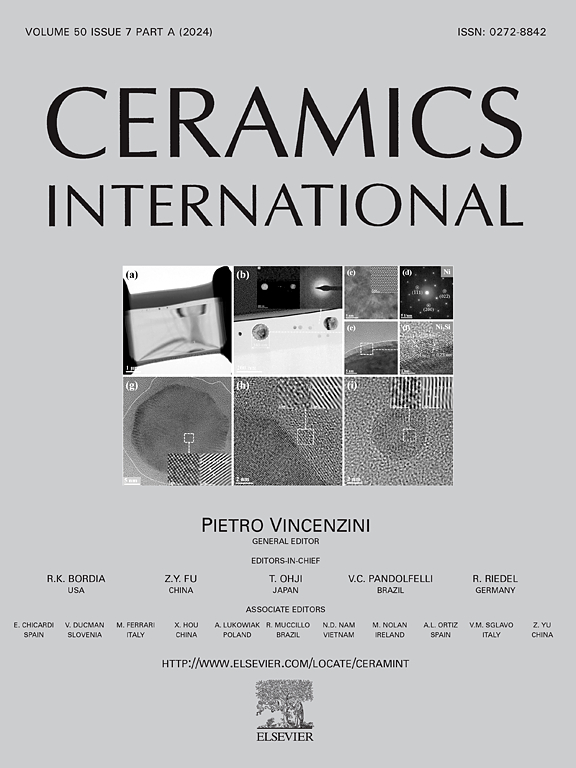采用簇-胶-原子模型设计单相(TiZr2HfNbTa)C5高熵碳化物
IF 5.1
2区 材料科学
Q1 MATERIALS SCIENCE, CERAMICS
引用次数: 0
摘要
高熵碳化物由于其在高温下的极端热稳定性而引起越来越多的关注。然而,他们的构图设计在很大程度上仍然是经验主义的。本文采用一种新颖的成分设计工具——团簇+胶原子模型,开发了mc型岩盐结构高熵碳化物。根据该模型,这种碳化物的组成单元是由一个以C为中心、6个M为壳层的最近邻配位簇,加上几个相邻的“胶”C组成,或者用簇式表示为[C-M6]Cx (x表示胶原子数),其中M6 = TiZr2HfNbTa。本文报道了Ti、Zr、Hf、Nb、Ta和C混合粉末在1600 ~ 2150℃、30 MPa单轴压力、5 Pa真空条件下烧结10 ~ 30 min合成(TiZr2HfNbTa)C5高熵碳化物的方法。特别是在2150℃下烧结20 min,形成单相态,维氏硬度HV为26.5 GPa,断裂韧性KIC为3.5 MPa m1/2,显著高于已有报道的岩盐型等摩尔碳化物(Ti0.2Zr0.2Hf0.2Nb0.2Ta0.2)C的22 GPa和3.0 MPa m1/2。本文章由计算机程序翻译,如有差异,请以英文原文为准。
Single-phase (TiZr2HfNbTa)C5 high-entropy carbide designed by cluster-plus-glue-atom model
High-entropy carbides are drawing increasing attention due to their extreme thermal stability at high temperatures. However, their composition design remains largely empirical. In the present work, a novel composition design tool, the cluster-plus-glue-atom model is used to develop MC-type rocksalt structure high-entropy carbide. According to this model, the composition unit in such a carbide is composed of a nearest-neighbor coordination cluster, centered by C and shelled by six M’s, plus a few next-neighbor “glue” C’s, or expressed in cluster formula as [C-M6]Cx (x represents the number of glue atoms), where M6 = TiZr2HfNbTa. We here report the synthesis of (TiZr2HfNbTa)C5 high-entropy carbide via sintering mixed Ti, Zr, Hf, Nb, Ta, and C powders at 1600–2150 °C for 10–30 min at a uniaxial pressure of 30 MPa under vacuum of 5 Pa. In particular, the sintering at 2150 °C for 20 min forms a single-phase state, reaching a Vickers hardness HV of 26.5 GPa and a fracture toughness KIC of 3.5 MPa m1/2, significantly higher than 22 GPa and 3.0 MPa m1/2 of the reported rocksalt-type equi-mole carbide (Ti0.2Zr0.2Hf0.2Nb0.2Ta0.2)C.
求助全文
通过发布文献求助,成功后即可免费获取论文全文。
去求助
来源期刊

Ceramics International
工程技术-材料科学:硅酸盐
CiteScore
9.40
自引率
15.40%
发文量
4558
审稿时长
25 days
期刊介绍:
Ceramics International covers the science of advanced ceramic materials. The journal encourages contributions that demonstrate how an understanding of the basic chemical and physical phenomena may direct materials design and stimulate ideas for new or improved processing techniques, in order to obtain materials with desired structural features and properties.
Ceramics International covers oxide and non-oxide ceramics, functional glasses, glass ceramics, amorphous inorganic non-metallic materials (and their combinations with metal and organic materials), in the form of particulates, dense or porous bodies, thin/thick films and laminated, graded and composite structures. Process related topics such as ceramic-ceramic joints or joining ceramics with dissimilar materials, as well as surface finishing and conditioning are also covered. Besides traditional processing techniques, manufacturing routes of interest include innovative procedures benefiting from externally applied stresses, electromagnetic fields and energetic beams, as well as top-down and self-assembly nanotechnology approaches. In addition, the journal welcomes submissions on bio-inspired and bio-enabled materials designs, experimentally validated multi scale modelling and simulation for materials design, and the use of the most advanced chemical and physical characterization techniques of structure, properties and behaviour.
Technologically relevant low-dimensional systems are a particular focus of Ceramics International. These include 0, 1 and 2-D nanomaterials (also covering CNTs, graphene and related materials, and diamond-like carbons), their nanocomposites, as well as nano-hybrids and hierarchical multifunctional nanostructures that might integrate molecular, biological and electronic components.
 求助内容:
求助内容: 应助结果提醒方式:
应助结果提醒方式:


